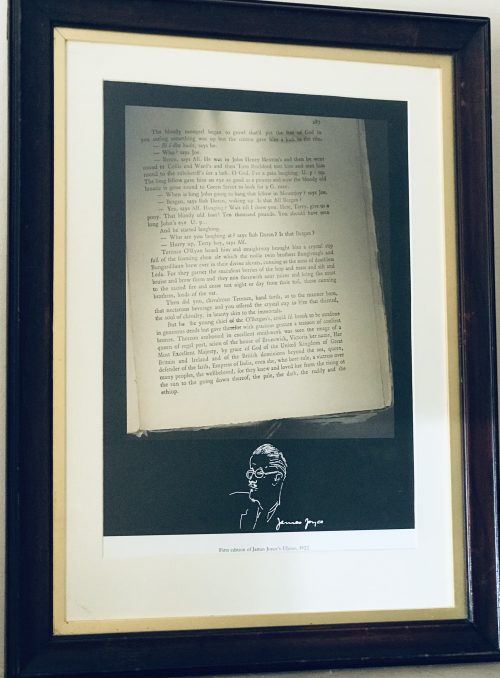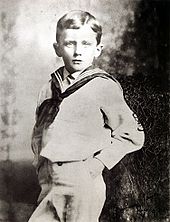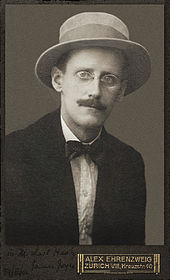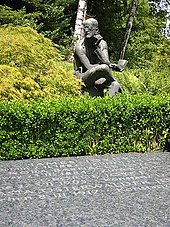James Augustine Aloysius Joyce (2 February 1882 – 13 January 1941) was an Irish novelist, short story writer, poet, teacher, and literary critic. He contributed to the
modernist avant-garde and is regarded as one of the most influential and important authors of the 20th century. Joyce is best known for
Ulysses (1922), a landmark work in which the episodes of
Homer's
Odyssey are paralleled in a variety of literary styles, most famously
stream of consciousness. Other well-known works are the short-story collection
Dubliners (1914), and the novels
A Portrait of the Artist as a Young Man (1916) and
Finnegans Wake (1939). His other writings include three books of poetry, a play, his published letters and occasional journalism.
Joyce was born in
Dublin into a middle-class family. A brilliant student, he briefly attended the Christian Brothers-run
O'Connell School before excelling at the Jesuit schools
Clongowes and
Belvedere, despite the chaotic family life imposed by his father's unpredictable finances. He went on to attend
University College Dublin.
In 1904, in his early twenties, Joyce emigrated to continental Europe with his partner (and later wife)
Nora Barnacle. They lived in
Trieste,
Paris, and
Zürich. Although most of his adult life was spent abroad, Joyce's fictional universe centres on Dublin and is populated largely by characters who closely resemble family members, enemies and friends from his time there.
Ulysses in particular is set with precision in the streets and alleyways of the city. Shortly after the publication of
Ulysses, he elucidated this preoccupation somewhat, saying, "For myself, I always write about Dublin, because if I can get to the heart of Dublin I can get to the heart of all the cities of the world. In the particular is contained the universal."

Joyce's birth and baptismal certificate
On 2 February 1882, Joyce was born at 41 Brighton Square,
Rathgar,
Dublin, Ireland.
Joyce's father was
John Stanislaus Joyce and his mother was Mary Jane "May" Murray. He was the eldest of ten surviving siblings; two died of
typhoid. James was baptised according to the Rites of the
Catholic Church in the nearby St Joseph's Church in
Terenure on 5 February 1882 by Rev. John O'Mulloy. Joyce's godparents were Philip and Ellen McCann.
John Stanislaus Joyce's family came from
Fermoy in
County Cork, and had owned a small salt and lime works. Joyce's paternal grandfather, James Augustine Joyce, married Ellen O'Connell, daughter of John O'Connell, a Cork Alderman who owned a drapery business and other properties in Cork City. Ellen's family claimed kinship with
Daniel O'Connell, "The Liberator".
The Joyce family's purported ancestor,
Seán Mór Seoighe (fl. 1680) was a stonemason from
Connemara.
In 1887, his father was appointed rate collector by
Dublin Corporation; the family subsequently moved to the fashionable adjacent small town of
Bray, 12 miles (19 km) from Dublin. Around this time Joyce was attacked by a dog, leading to his lifelong
cynophobia. He suffered from
astraphobia; a superstitious aunt had described thunderstorms as a sign of God's wrath.
In 1891 Joyce wrote a poem on the death of
Charles Stewart Parnell. His father was angry at the treatment of Parnell by the Catholic Church, the
Irish Home Rule Party and the
British Liberal Party and the resulting collaborative failure to secure Home Rule for Ireland. The Irish Party had dropped Parnell from leadership. But the Vatican's role in allying with the
British Conservative Party to prevent Home Rule left a lasting impression on the young Joyce.
The elder Joyce had the poem printed and even sent a part to the
Vatican Library. In November, John Joyce was entered in
Stubbs' Gazette (a publisher of bankruptcies) and suspended from work. In 1893, John Joyce was dismissed with a pension, beginning the family's slide into poverty caused mainly by his drinking and financial mismanagement.
Joyce had begun his education at
Clongowes Wood College, a
Jesuit boarding school near
Clane, County Kildare, in 1888 but had to leave in 1892 when his father could no longer pay the fees. Joyce then studied at home and briefly at the
Christian Brothers O'Connell School on North Richmond Street, Dublin, before he was offered a place in the Jesuits' Dublin school,
Belvedere College, in 1893. This came about because of a chance meeting his father had with a Jesuit priest called
John Conmee who knew the family and Joyce was given a reduction in fees to attend Belvedere.
In 1895, Joyce, now aged 13, was elected to join the
Sodality of Our Lady by his peers at Belvedere.
The philosophy of
Thomas Aquinas continued to have a strong influence on him for most of his life.
Education
Joyce enrolled at the recently established
University College Dublin (UCD) in 1898, studying English, French and Italian. He became active in theatrical and literary circles in the city. In 1900 his laudatory review of
Henrik Ibsen's
When We Dead Awaken was published in
The Fortnightly Review; it was his first publication and, after learning basic Norwegian to send a fan letter to Ibsen, he received a letter of thanks from the dramatist. Joyce wrote a number of other articles and at least two plays (since lost) during this period. Many of the friends he made at University College Dublin appeared as characters in Joyce's works. His closest colleagues included leading figures of the generation, most notably,
Tom Kettle,
Francis Sheehy-Skeffington and
Oliver St. John Gogarty. Joyce was first introduced to the Irish public by
Arthur Griffith in his newspaper,
United Irishman, in November 1901. Joyce had written an article on the
Irish Literary Theatre and his college magazine refused to print it. Joyce had it printed and distributed locally. Griffith himself wrote a piece decrying the censorship of the student James Joyce.
In 1901, the National Census of Ireland lists James Joyce (19) as an English- and
Irish-speaking scholar living with his mother and father, six sisters and three brothers at Royal Terrace (now Inverness Road),
Clontarf, Dublin.
After graduating from UCD in 1902, Joyce left for Paris to study medicine, but he soon abandoned this. Richard Ellmann suggests that this may have been because he found the technical lectures in French too difficult. Joyce had already failed to pass chemistry in English in Dublin. But Joyce claimed ill health as the problem and wrote home that he was unwell and complained about the cold weather.
He stayed on for a few months, appealing for finance his family could ill-afford and reading late in the
Bibliothèque Sainte-Geneviève. When his mother was diagnosed with cancer, his father sent a telegram which read, "NOTHER [
sic] DYING COME HOME FATHER".
Joyce returned to Ireland. Fearing for her son's impiety, his mother tried unsuccessfully to get Joyce to make his confession and to take communion. She finally passed into a coma and died on 13 August, James and his brother
Stanislaus having refused to kneel with other members of the family praying at her bedside.
After her death he continued to drink heavily, and conditions at home grew quite appalling. He scraped together a living reviewing books, teaching, and singing—he was an accomplished
tenor, and won the bronze medal in the 1904
Feis Ceoil.
Career
On 7 January 1904, Joyce attempted to publish
A Portrait of the Artist, an essay-story dealing with
aesthetics, only to have it rejected by the free-thinking magazine
Dana. He decided, on his twenty-second birthday, to revise the story into a novel he called
Stephen Hero. It was a fictional rendering of Joyce's youth, but he eventually grew frustrated with its direction and abandoned this work. It was never published in this form, but years later, in Trieste, Joyce completely rewrote it as
A Portrait of the Artist as a Young Man. The unfinished
Stephen Hero was published after his death.
Also in 1904, he met
Nora Barnacle, a young woman from
Galway city who was working as a chambermaid. On 16 June 1904 they had their first outing together, walking to the Dublin suburb of
Ringsend, where Nora
masturbated him. This event was commemorated by providing the date for the action of
Ulysses (as "
Bloomsday").
Joyce remained in Dublin for some time longer, drinking heavily. After one of his drinking binges, he got into a fight over a misunderstanding with a man in
St Stephen's Green;
he was picked up and dusted off by a minor acquaintance of his father, Alfred H. Hunter, who took him into his home to tend to his injuries.
Hunter was rumoured to be a Jew and to have an unfaithful wife and would serve as one of the models for
Leopold Bloom, the protagonist of
Ulysses.
He took up with the medical student Oliver St. John Gogarty, who informed the character for
Buck Mulligan in
Ulysses. After six nights in the
Martello Tower that Gogarty was renting in Sandycove, he left in the middle of the night following an altercation which involved another student he lived with, the unstable Dermot Chenevix Trench (Haines in
Ulysses), who fired a pistol at some pans hanging directly over Joyce's bed.
Joyce walked the 8 miles (13 km) back to Dublin to stay with relatives for the night, and sent a friend to the tower the next day to pack his trunk. Shortly after, the couple left Ireland to live on the continent.
1904–20: Trieste and Zürich
Joyce and Nora went into self-imposed exile, moving first to Zürich in Switzerland, where he ostensibly taught English at the
Berlitz Language School through an agent in England. It later became evident that the agent had been swindled; the director of the school sent Joyce on to
Trieste, which was then part of
Austria-Hungary (until the First World War), and is today part of Italy. Once again, he found there was no position for him, but with the help of Almidano Artifoni, director of the Trieste Berlitz School, he finally secured a teaching position in
Pola, then also part of Austria-Hungary (today part of
Croatia). He stayed there, teaching English mainly to Austro-Hungarian naval officers stationed at the Pola base, from October 1904 until March 1905, when the Austrians—having discovered an espionage ring in the city—expelled all
aliens. With Artifoni's help, he moved back to Trieste and began teaching English there. He remained in Trieste for most of the next ten years.
Later that year Nora gave birth to their first child, George (known as Giorgio). Joyce persuaded his brother, Stanislaus, to join him in Trieste, and secured a teaching position for him at the school. Joyce sought to augment his family's meagre income with his brother's earnings.
Stanislaus and Joyce had strained relations while they lived together in Trieste, arguing about Joyce's drinking habits and frivolity with money.
Joyce became frustrated with life in Trieste and moved to Rome in late 1906, taking employment as a clerk in a bank. He disliked Rome and returned to Trieste in early 1907. His daughter
Lucia was born later that year.
Joyce returned to Dublin in mid-1909 with George, to visit his father and work on getting
Dubliners published. He visited Nora's family in
Galway and liked Nora's mother very much.
While preparing to return to Trieste he decided to take one of his sisters, Eva, back with him to help Nora run the home. He spent a month in Trieste before returning to Dublin, this time as a representative of some cinema owners and businessmen from Trieste. With their backing he launched Ireland's first cinema, the
Volta Cinematograph, which was well-received, but fell apart after Joyce left. He returned to Trieste in January 1910 with another sister, Eileen, in tow.
Eva became homesick for Dublin and returned there a few years later, but Eileen spent the rest of her life on the continent, eventually marrying the
Czech bank cashier Frantisek Schaurek.
Joyce returned to Dublin again briefly in mid-1912 during his years-long fight with Dublin publisher George Roberts over the publication of
Dubliners. His trip was once again fruitless, and on his return he wrote the poem "Gas from a Burner", an invective against Roberts. After this trip, he never again came closer to Dublin than London, despite many pleas from his father and invitations from his fellow Irish writer
William Butler Yeats.
One of his students in Trieste was Ettore Schmitz, better known by the pseudonym
Italo Svevo. They met in 1907 and became lasting friends and mutual critics. Schmitz was a Catholic of Jewish origin and became a primary model for Leopold Bloom; most of the details about the
Jewish faith in
Ulysses came from Schmitz's responses to queries from Joyce.
While living in Trieste, Joyce was first beset with eye problems that ultimately required over a dozen surgical operations.
Joyce concocted a number of money-making schemes during this period, including an attempt to become a cinema
magnate in Dublin. He frequently discussed but ultimately abandoned a plan to import Irish tweed to Trieste. Correspondence relating to that venture with the Irish Woollen Mills were for a long time displayed in the windows of their premises in
Dublin. Joyce's skill at borrowing money saved him from indigence. What income he had came partially from his position at the Berlitz school and partially from teaching private students.
In 1915, after most of his students in Trieste were conscripted to fight in the
Great War, Joyce moved to Zürich. Two influential private students, Baron Ambrogio Ralli and Count Francesco Sordina, petitioned officials for an exit permit for the Joyces, who in turn agreed not to take any action against the emperor of Austria-Hungary during the war.
During this period Joyce took an active interest in
socialism.
He had attended socialist meetings when he was still in Dublin and 1905, while in Trieste, he described his politics as "those of a socialist artist."
Although his practical engagement waned after 1907 due to the "endless internecine warfare" he observed in socialist organizations, many Joyce scholars such as
Richard Ellmann, Dominic Manganiello,
Robert Scholes, and George J. Watson agree that Joyce's interest in socialism and pacifistic anarchism continued for much of his life, and that both the form and content of Joyce's work reflect a sympathy for democratic and socialist ideas.
In 1918 he declared himself "against every state"
and found much succor in the individualist philosophies of
Benjamin Tucker and
Oscar Wilde's
The Soul of Man Under Socialism.
Later in the 1930s, Joyce rated his experiences with the defeated multi-ethnic Habsburg Empire as: "They called the Empire a ramshackle empire, I wish to God there were more such empires."
1920–41: Paris and Zürich
Joyce set himself to finishing
Ulysses in Paris, delighted to find that he was gradually gaining fame as an avant-garde writer. A further grant from
Harriet Shaw Weaver meant he could devote himself full-time to writing again, as well as consort with other literary figures in the city. During this time, Joyce's eyes began to give him more and more problems and he often wore an
eyepatch. He was treated by Louis Borsch in Paris, undergoing nine operations before Borsch's death in 1929.
Throughout the 1930s he travelled frequently to Switzerland for eye surgeries and for treatments for his daughter Lucia, who, according to the Joyces, suffered from
schizophrenia. Lucia was analysed by
Carl Jung at the time, who after reading
Ulysses is said to have concluded that her father had schizophrenia.
Jung said that she and her father were two people heading to the bottom of a river, except that Joyce was diving and Lucia was sinking.
In Paris,
Maria and
Eugene Jolas nursed Joyce during his long years of writing
Finnegans Wake. Were it not for their support (along with Harriet Shaw Weaver's constant financial support), there is a good possibility that his books might never have been finished or published. In their literary magazine
transition, the Jolases published serially various sections of
Finnegans Wake under the title
Work in Progress. Joyce returned to Zürich in late 1940, fleeing the
Nazi occupation of France. Joyce used his contacts to help some sixteen Jews escape Nazi persecution.
Joyce and religion
The issue of Joyce's relationship with religion is somewhat controversial. Early in life, he lapsed from Catholicism, according to first-hand testimonies coming from himself, his brother Stanislaus Joyce, and his wife:
My mind rejects the whole present social order and Christianity—home, the recognised virtues, classes of life and religious doctrines. ... Six years ago I left the Catholic church, hating it most fervently. I found it impossible for me to remain in it on account of the impulses of my nature. I made secret war upon it when I was a student and declined to accept the positions it offered me. By doing this I made myself a beggar but I retained my pride. Now I make open war upon it by what I write and say and do.
When the arrangements for Joyce's burial were being made, a Catholic priest offered a religious service, which Joyce's wife, Nora, declined, saying, "I couldn't do that to him."
Leonard Strong, William T. Noon, Robert Boyle and others have argued that Joyce, later in life, reconciled with the faith he rejected earlier in life and that his parting with the faith was succeeded by a not so obvious reunion, and that
Ulysses and
Finnegans Wake are essentially Catholic expressions.
Likewise,
Hugh Kenner and
T. S. Eliot believed they saw between the lines of Joyce's work the outlook of a serious Christian and that beneath the veneer of the work lies a remnant of Catholic belief and attitude.
Kevin Sullivan maintains that, rather than reconciling with the faith, Joyce never left it.
Critics holding this view insist that Stephen, the protagonist of the semi-autobiographical
A Portrait of the Artist as a Young Man as well as
Ulysses, is not Joyce.
Somewhat cryptically, in an interview after completing Ulysses, in response to the question "When did you leave the Catholic Church", Joyce answered, "That's for the Church to say."
Eamonn Hughes maintains that Joyce takes a
dialectic approach, both affirming and denying, saying that Stephen's much noted
non-serviam is qualified—"I will not serve
that which I no longer believe...", and that the
non-serviam will always be balanced by Stephen's "I am a servant..." and Molly's "yes".
He attended Catholic Mass and Orthodox Divine Liturgy, especially during Holy Week, purportedly for aesthetic reasons.
His sisters noted his Holy Week attendance and that he did not seek to dissuade them.
One friend reported that Joyce cried "secret tears" upon hearing Jesus' words on the cross and another suggested that he was a "believer at heart" because of his frequent attendance at church.
Umberto Eco compares Joyce to the ancient
episcopi vagantes (wandering bishops) in the
Middle Ages. They left a discipline, not a cultural heritage or a way of thinking. Like them, the writer retains the sense of
blasphemy held as a liturgical ritual.
Some critics and biographers have opined along the lines of
Andrew Gibson: "The modern James Joyce may have vigorously resisted the oppressive power of Catholic tradition. But there was another Joyce who asserted his allegiance to that tradition, and never left it, or wanted to leave it, behind him." Gibson argues that Joyce "remained a Catholic intellectual if not a believer" since his thinking remained influenced by his cultural background, even though he lived apart from that culture.
His relationship with religion was complex and not easily understood, even perhaps by himself. He acknowledged the debt he owed to his early Jesuit training. Joyce told the sculptor
August Suter, that from his Jesuit education, he had 'learnt to arrange things in such a way that they become easy to survey and to judge.'
Death
On 11 January 1941, Joyce underwent surgery in Zürich for a
perforated duodenal ulcer. He fell into a coma the following day. He awoke at 2 a.m. on 13 January 1941, and asked a nurse to call his wife and son, before losing consciousness again. They were en route when he died 15 minutes later. Joyce was less than a month short of his 59th birthday.
His body was buried in the
Fluntern Cemetery, Zürich. The Swiss tenor
Max Meili sang
Addio terra, addio cielo from
Monteverdi's
L'Orfeo at the burial service.
Although two senior Irish diplomats were in Switzerland at the time, neither attended Joyce's funeral, and the Irish government later declined Nora's offer to permit the repatriation of Joyce's remains. When
Joseph Walshe, secretary at the Department of External Affairs in Dublin, was informed of Joyce's death by Frank Cremins,
chargé d'affaires at
Bern, Walshe responded "Please wire details of Joyce's death. If possible find out did he die a Catholic? Express sympathy with Mrs Joyce and explain inability to attend funeral".
Buried originally in an ordinary grave, Joyce was moved in 1966 to a more prominent "honour grave," with a seated portrait statue by American artist
Milton Hebald nearby. Nora, whom he had married in 1931, survived him by 10 years. She is buried by his side, as is their son Giorgio, who died in 1976.
In October 2019 a motion was put to
Dublin City Council to plan and budget for the costs of the exhumations and reburials of Joyce and his family somewhere in Dublin, subject to his family's wishes.
The proposal immediately became controversial, with the
Irish Times commenting: "...it is hard not to suspect that there is a calculating, even mercantile, aspect to contemporary Ireland's relationship to its great writers, whom we are often more keen to 'celebrate', and if possible monetise, than read".
Major works

The title page of the first edition of
Dubliners
Dubliners is a collection of fifteen short stories by Joyce, first published in 1914.
They form a naturalistic depiction of Irish middle-class life in and around Dublin in the early years of the 20th century.
The stories were written when Irish nationalism was at its peak and a search for a national identity and purpose was raging; at a crossroads of history and culture, Ireland was jolted by converging ideas and influences. The stories centre on Joyce's idea of an epiphany: a moment when a character experiences a life-changing self-understanding or illumination. Many of the characters in
Dubliners later appear in minor roles in Joyce's novel
Ulysses.
The initial stories in the collection are narrated by child protagonists. Subsequent stories deal with the lives and concerns of progressively older people. This aligns with Joyce's tripartite division of the collection into childhood, adolescence and maturity.
A Portrait of the Artist as a Young Man
A Portrait of the Artist as a Young Man is a nearly complete rewrite of the abandoned novel
Stephen Hero. Joyce attempted to burn the original manuscript in a fit of rage during an argument with Nora, though to his subsequent relief it was rescued by his sister. A
Künstlerroman,
Portrait is a heavily autobiographical
coming-of-age novel depicting the childhood and adolescence of the protagonist
Stephen Dedalus and his gradual growth into artistic self-consciousness. Some hints of the techniques Joyce frequently employed in later works, such as
stream of consciousness,
interior monologue, and references to a character's psychic reality rather than to his external surroundings are evident throughout this novel.
Exiles and poetry
Despite early interest in the theatre, Joyce published only one play,
Exiles, begun shortly after the outbreak of the First World War in 1914 and published in 1918. A study of a husband-and-wife relationship, the play looks back to
The Dead (the final story in
Dubliners) and forward to
Ulysses, which Joyce began around the time of the play's composition.
Joyce published a number of books of poetry. His first mature published work was the satirical broadside "The Holy Office" (1904), in which he proclaimed himself to be the superior of many prominent members of the
Celtic Revival. His first full-length poetry collection,
Chamber Music (1907; referring, Joyce joked, to the sound of urine hitting the side of a chamber pot), consisted of 36 short lyrics. This publication led to his inclusion in the
Imagist Anthology, edited by
Ezra Pound, who was a champion of Joyce's work. Other poetry Joyce published in his lifetime include "Gas from a Burner" (1912),
Pomes Penyeach (1927) and "Ecce Puer" (written in 1932 to mark the birth of his grandson and the recent death of his father). It was published by the
Black Sun Press in
Collected Poems (1936).
Ulysses

Announcement of the initial publication of
Ulysses.
As he was completing work on
Dubliners in 1906, Joyce considered adding another story featuring a Jewish advertising canvasser called
Leopold Bloom under the title
Ulysses. Although he did not pursue the idea further at the time, he eventually commenced work on a novel using both the title and basic premise in 1914. The writing was completed in October 1921. Three more months were devoted to working on the proofs of the book before Joyce halted work shortly before his self-imposed deadline, his 40th birthday (2 February 1922).
Thanks to Ezra Pound, serial publication of the novel in the magazine
The Little Review began in March 1918. This magazine was edited by
Margaret C. Andersonand
Jane Heap, with the intermittent financial backing of
John Quinn, a successful New York commercial lawyer with an interest in contemporary experimental art and literature.
This provoked the first accusations of obscenity with which the book would be identified for so long. Its amorphous structure with frank, intimate musings (‘stream of consciousness’) were seen to offend both church and state. The publication encountered problems with
New York Postal Authorities; serialisation ground to a halt in December 1920; the editors were convicted of publishing
obscenity in February 1921.
Although the conviction was based on the "Nausicaä" episode of
Ulysses,
The Little Review had fuelled the fires of controversy with
dada poet
Elsa von Freytag-Loringhoven's defence of
Ulysses in an essay "The Modest Woman."
Joyce's novel was not published in the United States until 1934.
Partly because of this controversy, Joyce found it difficult to get a publisher to accept the book, but it was published in 1922 by
Sylvia Beach from her well-known
Rive Gauche bookshop,
Shakespeare and Company. An English edition published the same year by Joyce's patron, Harriet Shaw Weaver, ran into further difficulties with the United States authorities, and 500 copies that were shipped to the States were seized and possibly destroyed. The following year,
John Rodker produced a print run of 500 more intended to replace the missing copies, but these were burned by English customs at
Folkestone. A further consequence of the novel's ambiguous legal status as a banned book was that "bootleg" versions appeared, including pirate versions from the publisher
Samuel Roth. In 1928, a court injunction against Roth was obtained and he ceased publication.
With the appearance of
Ulysses, and
T.S. Eliot's poem,
The Waste Land, 1922 was a key year in the history of English-language literary modernism. In
Ulysses, Joyce employs stream of consciousness, parody, jokes, and almost every other literary technique to present his characters.
The action of the novel, which takes place in a single day, 16 June 1904, sets the characters and incidents of the
Odyssey of
Homer in modern Dublin and represents
Odysseus (Ulysses),
Penelope and
Telemachus in the characters of Leopold Bloom, his wife
Molly Bloom and Stephen Dedalus, parodically contrasted with their lofty models. The book explores various areas of Dublin life, dwelling on its squalor and monotony. Nevertheless, the book is also an affectionately detailed study of the city, and Joyce claimed that if Dublin were to be destroyed in some catastrophe it could be rebuilt, brick by brick, using his work as a model.
In order to achieve this level of accuracy, Joyce used the 1904 edition of
Thom's Directory—a work that listed the owners and/or tenants of every residential and commercial property in the city. He also bombarded friends still living there with requests for information and clarification.
The book consists of 18 chapters, each covering roughly one hour of the day, beginning around about 8 a.m. and ending sometime after 2 a.m. the following morning. Each of the 18 chapters of the novel employs its own literary style. Each chapter also refers to a specific episode in Homer's Odyssey and has a specific colour, art or science and bodily organ associated with it. This combination of kaleidoscopic writing with an extreme formal, schematic structure represents one of the book's major contributions to the development of 20th century modernist literature.
Other contributions include the use of
classical mythology as a framework for his book and the near-obsessive focus on external detail in a book in which much of the significant action is happening inside the minds of the characters. Nevertheless, Joyce complained that, "I may have oversystematised
Ulysses," and played down the mythic correspondences by eliminating the chapter titles that had been taken from Homer.
Joyce was reluctant to publish the chapter titles because he wanted his work to stand separately from the Greek form. It was only when
Stuart Gilbert published his critical work on
Ulysses in 1930 that the schema was supplied by Joyce to Gilbert. But as Terrence Killeen points out this schema was developed after the novel had been written and was not something that Joyce consulted as he wrote the novel.
Finnegans Wake
Having completed work on
Ulysses, Joyce was so exhausted that he did not write a line of prose for a year.
On 10 March 1923 he informed his patron, Harriet Shaw Weaver: "Yesterday I wrote two pages—the first I have since the final
Yes of
Ulysses. Having found a pen, with some difficulty I copied them out in a large handwriting on a double sheet of
foolscap so that I could read them.
Il lupo perde il pelo ma non il vizio, the Italians say. 'The wolf may lose his skin but not his vice' or 'the leopard cannot change his spots.'"
Thus was born a text that became known, first, as
Work in Progress and later
Finnegans Wake.
By 1926 Joyce had completed the first two parts of the book. In that year, he met Eugene and Maria Jolas who offered to serialise the book in their magazine
transition. For the next few years, Joyce worked rapidly on the new book, but in the 1930s, progress slowed considerably. This was due to a number of factors, including the death of his father in 1931, concern over the mental health of his daughter
Lucia, and his own health problems, including failing eyesight. Much of the work was done with the assistance of younger admirers, including
Samuel Beckett. For some years, Joyce nursed the eccentric plan of turning over the book to his friend
James Stephens to complete, on the grounds that Stephens was born in the same hospital as Joyce exactly one week later, and shared the first name of both Joyce and of Joyce's fictional alter-ego, an example of Joyce's superstitions.
Reaction to the work was mixed, including negative comment from early supporters of Joyce's work, such as Pound and the author's brother, Stanislaus Joyce.
To counteract this hostile reception, a book of essays by supporters of the new work, including Beckett,
William Carlos Williams and others was organised and published in 1929 under the title











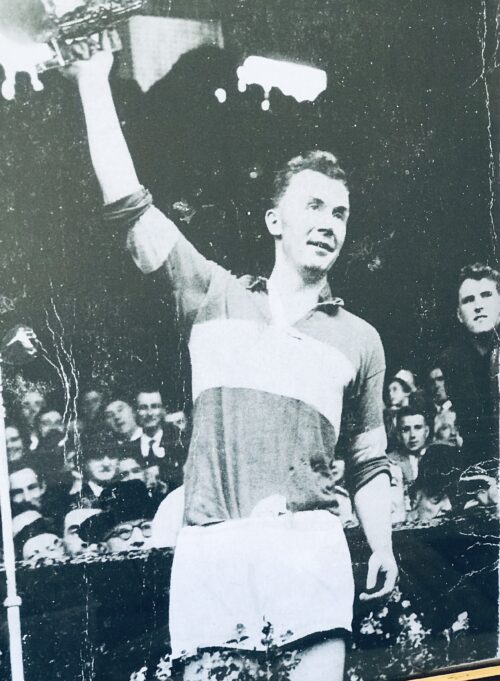
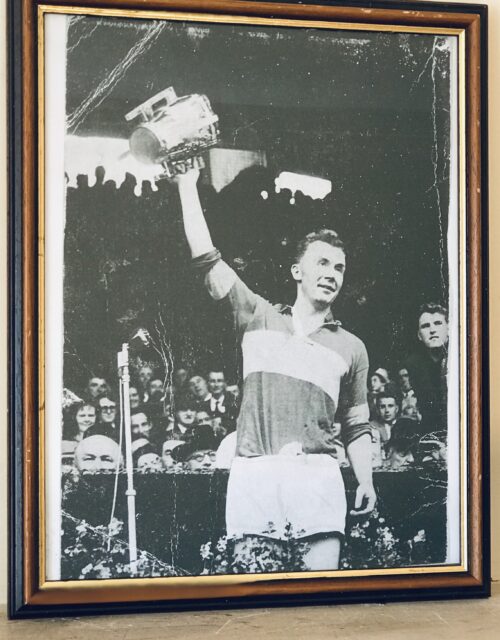


 Tom Moloughney, Jimmy Doyle, and Kieran Carey relax in the dressing room after Tipperary’s victory over Dublin in the 1961 All-Ireland final, a success that was to be repeated the following year. Picture from ‘The GAA — A People’s History’
Tom Moloughney, Jimmy Doyle, and Kieran Carey relax in the dressing room after Tipperary’s victory over Dublin in the 1961 All-Ireland final, a success that was to be repeated the following year. Picture from ‘The GAA — A People’s History’


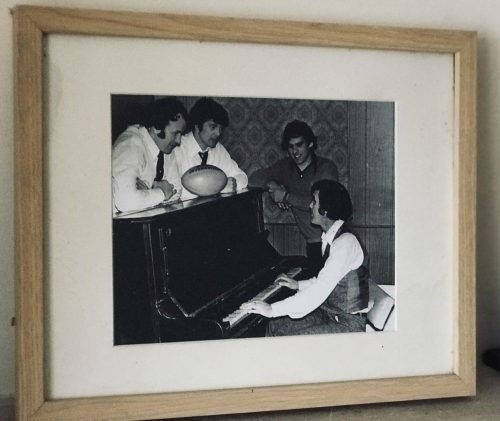

 Many years on, Stuart Wilson vividly recalled the Dennison tackles and spoke about them in remarkable detail and with commendable honesty: “The move involved me coming in from the blind side wing and it had been working very well on tour. It was a workable move and it was paying off so we just kept rolling it out. Against Munster, the gap opened up brilliantly as it was supposed to except that there was this little guy called Seamus Dennison sitting there in front of me.
“He just basically smacked the living daylights out of me. I dusted myself off and thought, I don’t want to have to do that again. Ten minutes later, we called the same move again thinking we’d change it slightly but, no, it didn’t work and I got hammered again.”
The game was 11 minutes old when the most famous try in the history of Munster rugby was scored.
Tom Kiernan recalled: “It came from a great piece of anticipation by Bowen who in the first place had to run around his man to get to Ward’s kick ahead. He then beat two men and when finally tackled, managed to keep his balance and deliver the ball to Cantillon who went on to score. All of this was evidence of sharpness on Bowen’s part.”
Very soon it would be 9-0. In the first five minutes, a towering garryowen by skipper Canniffe had exposed the vulnerability of the New Zealand rearguard under the high ball. They were to be examined once or twice more but it was from a long range but badly struck penalty attempt by Ward that full-back Brian McKechnie knocked on some 15 yards from his line and close to where Cantillon had touched down a few minutes earlier. You could sense White, Whelan, McLoughlin and co in the front five of the Munster scrum smacking their lips as they settled for the scrum. A quick, straight put-in by Canniffe, a well controlled heel, a smart pass by the scrum-half to Ward and the inevitability of a drop goal. And that’s exactly what happened.
The All Blacks enjoyed the majority of forward possession but the harder they tried, the more they fell into the trap set by the wily Kiernan and so brilliantly carried out by every member of the Munster team.
The tourists might have edged the line-out contest through Andy Haden and Frank Oliver but scrum-half Mark Donaldson endured a miserable afternoon as the Munster forwards poured through and buried him in the Thomond Park turf.
As the minutes passed and the All Blacks became more and more unsure as to what to try next, the Thomond Park hordes chanted “Munster-Munster–Munster” to an ever increasing crescendo until with 12 minutes to go, the noise levels reached deafening proportions.
And then ... a deep, probing kick by Ward put Wilson under further pressure. Eventually, he stumbled over the ball as it crossed the line and nervously conceded a five-metre scrum. The Munster heel was disrupted but the ruck was won, Tucker gained possession and slipped a lovely little pass to Ward whose gifted feet and speed of thought enabled him in a twinkle to drop a goal although surrounded by a swarm of black jerseys. So the game entered its final 10 minutes with the All Blacks needing three scores to win and, of course, that was never going to happen.
Munster knew this, so, too, did the All Blacks. Stu Wilson admitted as much as he explained his part in Wardy’s second drop goal: “Tony Ward banged it down, it bounced a little bit, jigged here, jigged there, and I stumbled, fell over, and all of a sudden the heat was on me. They were good chasers. A kick is a kick — but if you have lots of good chasers on it, they make bad kicks look good. I looked up and realised — I’m not going to run out of here so I just dotted it down. I wasn’t going to run that ball back out at them because five of those mad guys were coming down the track at me and I’m thinking, I’m being hit by these guys all day and I’m looking after my body, thank you. Of course it was a five-yard scrum and Ward banged over another drop goal. That was it, there was the game”.
The final whistle duly sounded with Munster 12 points ahead but the heroes of the hour still had to get off the field and reach the safety of the dressing room. Bodies were embraced, faces were kissed, backs were pummelled, you name it, the gauntlet had to be walked. Even the All Blacks seemed impressed with the sense of joy being released all about them. Andy Haden recalled “the sea of red supporters all over the pitch after the game, you could hardly get off for the wave of celebration that was going on. The whole of Thomond Park glowed in the warmth that someone had put one over on the Blacks.”
Controversially, the All Blacks coach, Jack Gleeson (usually a man capable of accepting the good with the bad and who passed away of cancer within 12 months of the tour), in an unguarded (although possibly misunderstood) moment on the following day, let slip his innermost thoughts on the game.
“We were up against a team of kamikaze tacklers,” he lamented. “We set out on this tour to play 15-man rugby but if teams were to adopt the Munster approach and do all they could to stop the All Blacks from playing an attacking game, then the tour and the game would suffer.”
It was interpreted by the majority of observers as a rare piece of sour grapes from a group who had accepted the defeat in good spirit and it certainly did nothing to diminish Munster respect for the All Blacks and their proud rugby tradition.
Many years on, Stuart Wilson vividly recalled the Dennison tackles and spoke about them in remarkable detail and with commendable honesty: “The move involved me coming in from the blind side wing and it had been working very well on tour. It was a workable move and it was paying off so we just kept rolling it out. Against Munster, the gap opened up brilliantly as it was supposed to except that there was this little guy called Seamus Dennison sitting there in front of me.
“He just basically smacked the living daylights out of me. I dusted myself off and thought, I don’t want to have to do that again. Ten minutes later, we called the same move again thinking we’d change it slightly but, no, it didn’t work and I got hammered again.”
The game was 11 minutes old when the most famous try in the history of Munster rugby was scored.
Tom Kiernan recalled: “It came from a great piece of anticipation by Bowen who in the first place had to run around his man to get to Ward’s kick ahead. He then beat two men and when finally tackled, managed to keep his balance and deliver the ball to Cantillon who went on to score. All of this was evidence of sharpness on Bowen’s part.”
Very soon it would be 9-0. In the first five minutes, a towering garryowen by skipper Canniffe had exposed the vulnerability of the New Zealand rearguard under the high ball. They were to be examined once or twice more but it was from a long range but badly struck penalty attempt by Ward that full-back Brian McKechnie knocked on some 15 yards from his line and close to where Cantillon had touched down a few minutes earlier. You could sense White, Whelan, McLoughlin and co in the front five of the Munster scrum smacking their lips as they settled for the scrum. A quick, straight put-in by Canniffe, a well controlled heel, a smart pass by the scrum-half to Ward and the inevitability of a drop goal. And that’s exactly what happened.
The All Blacks enjoyed the majority of forward possession but the harder they tried, the more they fell into the trap set by the wily Kiernan and so brilliantly carried out by every member of the Munster team.
The tourists might have edged the line-out contest through Andy Haden and Frank Oliver but scrum-half Mark Donaldson endured a miserable afternoon as the Munster forwards poured through and buried him in the Thomond Park turf.
As the minutes passed and the All Blacks became more and more unsure as to what to try next, the Thomond Park hordes chanted “Munster-Munster–Munster” to an ever increasing crescendo until with 12 minutes to go, the noise levels reached deafening proportions.
And then ... a deep, probing kick by Ward put Wilson under further pressure. Eventually, he stumbled over the ball as it crossed the line and nervously conceded a five-metre scrum. The Munster heel was disrupted but the ruck was won, Tucker gained possession and slipped a lovely little pass to Ward whose gifted feet and speed of thought enabled him in a twinkle to drop a goal although surrounded by a swarm of black jerseys. So the game entered its final 10 minutes with the All Blacks needing three scores to win and, of course, that was never going to happen.
Munster knew this, so, too, did the All Blacks. Stu Wilson admitted as much as he explained his part in Wardy’s second drop goal: “Tony Ward banged it down, it bounced a little bit, jigged here, jigged there, and I stumbled, fell over, and all of a sudden the heat was on me. They were good chasers. A kick is a kick — but if you have lots of good chasers on it, they make bad kicks look good. I looked up and realised — I’m not going to run out of here so I just dotted it down. I wasn’t going to run that ball back out at them because five of those mad guys were coming down the track at me and I’m thinking, I’m being hit by these guys all day and I’m looking after my body, thank you. Of course it was a five-yard scrum and Ward banged over another drop goal. That was it, there was the game”.
The final whistle duly sounded with Munster 12 points ahead but the heroes of the hour still had to get off the field and reach the safety of the dressing room. Bodies were embraced, faces were kissed, backs were pummelled, you name it, the gauntlet had to be walked. Even the All Blacks seemed impressed with the sense of joy being released all about them. Andy Haden recalled “the sea of red supporters all over the pitch after the game, you could hardly get off for the wave of celebration that was going on. The whole of Thomond Park glowed in the warmth that someone had put one over on the Blacks.”
Controversially, the All Blacks coach, Jack Gleeson (usually a man capable of accepting the good with the bad and who passed away of cancer within 12 months of the tour), in an unguarded (although possibly misunderstood) moment on the following day, let slip his innermost thoughts on the game.
“We were up against a team of kamikaze tacklers,” he lamented. “We set out on this tour to play 15-man rugby but if teams were to adopt the Munster approach and do all they could to stop the All Blacks from playing an attacking game, then the tour and the game would suffer.”
It was interpreted by the majority of observers as a rare piece of sour grapes from a group who had accepted the defeat in good spirit and it certainly did nothing to diminish Munster respect for the All Blacks and their proud rugby tradition.
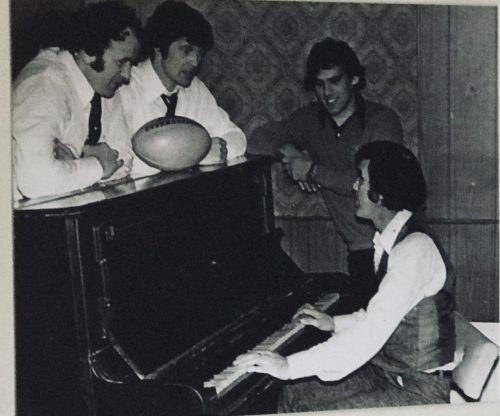
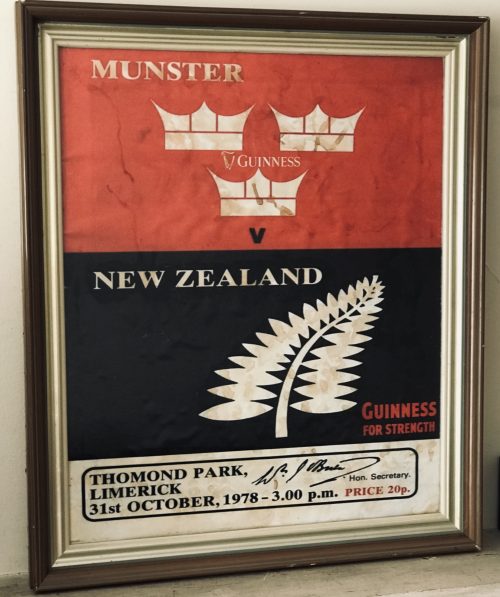
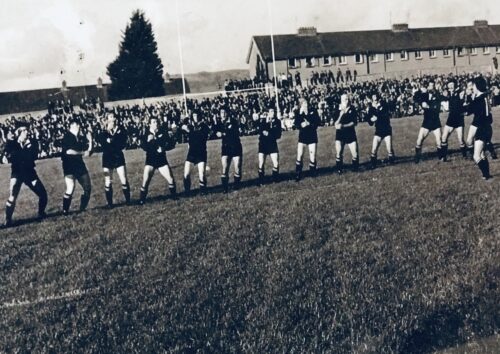
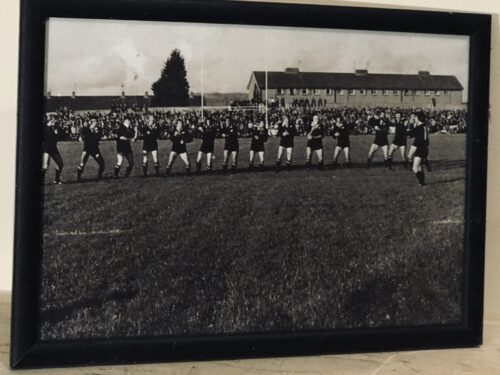
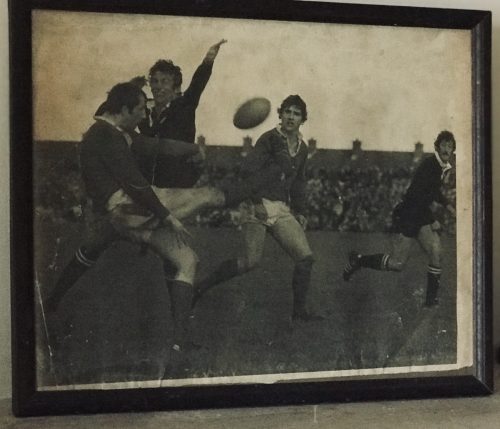
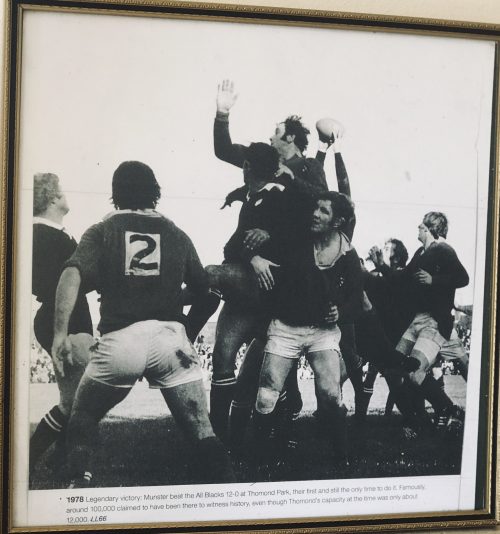



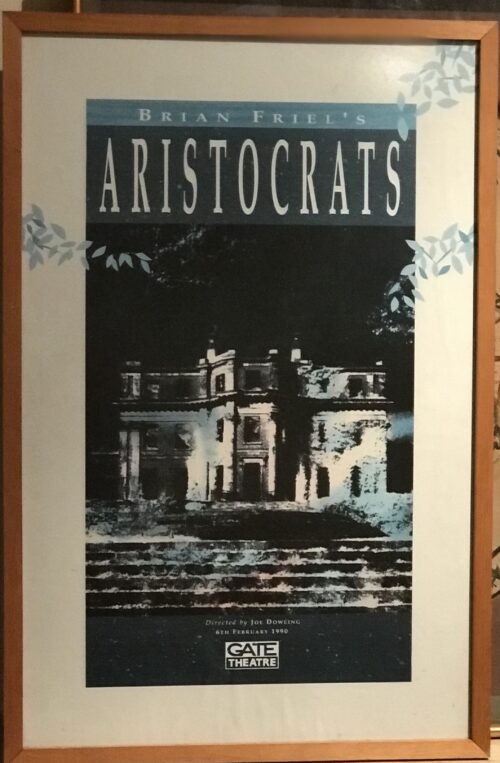
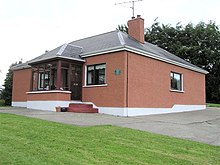




 Charlton had beaten late entrant Bob Paisley, a multiple trophy winner, to the FAI hot seat, and his introduction to the gathered press was a million miles away from the carefully staged managed productions of the modern day.
In fact, it almost turned into an impromptu David Haye and Tony Bellew pre-match fight when Charlton challenged hardened journalist and ex-international Eamon Dunphy’s line of questioning. That relationship turned increasingly sour as time went by.
Charlton had beaten late entrant Bob Paisley, a multiple trophy winner, to the FAI hot seat, and his introduction to the gathered press was a million miles away from the carefully staged managed productions of the modern day.
In fact, it almost turned into an impromptu David Haye and Tony Bellew pre-match fight when Charlton challenged hardened journalist and ex-international Eamon Dunphy’s line of questioning. That relationship turned increasingly sour as time went by.
 This was the blueprint – or greenprint – of the Irish national team for the next decade.
Former players like Johnny Giles thought this indicated a lack of trust in the ability of players. Charlton saw it as pragmatic. His idea was to keep information and instruction simple.
This was the blueprint – or greenprint – of the Irish national team for the next decade.
Former players like Johnny Giles thought this indicated a lack of trust in the ability of players. Charlton saw it as pragmatic. His idea was to keep information and instruction simple.
 After a 1-0 defeat to Wales in his first match in charge, Charlton got to work on qualifying for the 1988 European Championship in West Germany.
After a 1-0 defeat to Wales in his first match in charge, Charlton got to work on qualifying for the 1988 European Championship in West Germany.
 While England staggered to defeat against the USSR and Holland, the Irish matched both teams stride for stride. Houghton described the 1-1 draw against the Soviets as “one of the best performances I’ve ever been involved in with Jack’s teams”.
While England staggered to defeat against the USSR and Holland, the Irish matched both teams stride for stride. Houghton described the 1-1 draw against the Soviets as “one of the best performances I’ve ever been involved in with Jack’s teams”.
 A 1-1 draw with the Dutch meant both teams had identical records as all three of Holland, England and Ireland progressed, with the Irish benefiting from the drawing of lots to qualify as group runners-up
After three drab stalemates, the party only truly began in Genoa against Romania in the last 16 – after another goalless game, Bonner saved Romania’s fifth penalty, leaving David O’Leary to take the decisive kick.
RTE commentator George Hamilton uttered the most important seven words Irish fans remember: “A nation holds its breath… We’re there!”
How ironic that the hero was O’Leary, another more football-minded defender that was often overlooked by Charlton.
O’Leary recalled: “There were about 20,000 brilliant Irish supporters behind the goal. They were so still and the eruption of green afterwards when the ball hit the net was absolutely amazing. It’s a fantastic memory.”
A 1-1 draw with the Dutch meant both teams had identical records as all three of Holland, England and Ireland progressed, with the Irish benefiting from the drawing of lots to qualify as group runners-up
After three drab stalemates, the party only truly began in Genoa against Romania in the last 16 – after another goalless game, Bonner saved Romania’s fifth penalty, leaving David O’Leary to take the decisive kick.
RTE commentator George Hamilton uttered the most important seven words Irish fans remember: “A nation holds its breath… We’re there!”
How ironic that the hero was O’Leary, another more football-minded defender that was often overlooked by Charlton.
O’Leary recalled: “There were about 20,000 brilliant Irish supporters behind the goal. They were so still and the eruption of green afterwards when the ball hit the net was absolutely amazing. It’s a fantastic memory.”
 Ireland’s propensity to draw a large proportion of games (30 out of 93 under Charlton) cost them dearly in the 1992 Euro qualifying group as only eight teams could qualify for Sweden.
They finished behind Graham Taylor’s stodgy England team, despite drawing home and away against them.
However, the Republic were reaching a new peak, with a young Roy Keane and Denis Irwin introduced to the team.
“The worst thing about missing out on Euro 92 was that Denmark won it. It should have been Ireland.” recalled a frustrated manager.
Ireland’s propensity to draw a large proportion of games (30 out of 93 under Charlton) cost them dearly in the 1992 Euro qualifying group as only eight teams could qualify for Sweden.
They finished behind Graham Taylor’s stodgy England team, despite drawing home and away against them.
However, the Republic were reaching a new peak, with a young Roy Keane and Denis Irwin introduced to the team.
“The worst thing about missing out on Euro 92 was that Denmark won it. It should have been Ireland.” recalled a frustrated manager.
 In the USA, the party started early in New York as Italy were beaten in the Big Apple by a Houghton strike.
Patrick Barclay summed it up best in The Observer: “Ireland’s blanket defence rendered vain all the creative endeavours of Roberto Baggio, who adorned this marvellous occasion but was not allowed to influence it because for 90 mins Jack Charlton’s sweat-soaked soldiers stayed about as close as ranks can get.”
Unfortunately, Ireland’s performances tailed off dramatically for the remainder of the tournament.
Such draining tactics were hard to administer in the humidity of Orlando, and the manager was banned from the touchline for venting his fury at officials over the lack of water for his troops against Mexico.
After squeezing through the group following a goalless draw with Norway, the Green bus ran out of fuel against the Dutch in the last 16.
In the USA, the party started early in New York as Italy were beaten in the Big Apple by a Houghton strike.
Patrick Barclay summed it up best in The Observer: “Ireland’s blanket defence rendered vain all the creative endeavours of Roberto Baggio, who adorned this marvellous occasion but was not allowed to influence it because for 90 mins Jack Charlton’s sweat-soaked soldiers stayed about as close as ranks can get.”
Unfortunately, Ireland’s performances tailed off dramatically for the remainder of the tournament.
Such draining tactics were hard to administer in the humidity of Orlando, and the manager was banned from the touchline for venting his fury at officials over the lack of water for his troops against Mexico.
After squeezing through the group following a goalless draw with Norway, the Green bus ran out of fuel against the Dutch in the last 16.

 It is sometimes opined in retrospect that the Republic could have done better with the quality of players at their disposal. They only won one of nine World Cup matches, scoring just four goals.
After USA’ 94, Dunphy said: “The minority who know their football well enough to distinguish between fact and fantasy have long since decided that even though the show is great, the football of the Charlton era has been, too often, lousy.”
But would liberation have taken away the organisational pragmatism that was central to the Green Wall being breached just 41 times in 93 games? After all, this was a team that also beat Brazil at home and Germany in Hannover.
Niall Quinn said: “We were happy as we were – beautiful, skilled losers.”
Big Jack made them coarse but clinical winners on the pitch and a lot happier off it.
It is sometimes opined in retrospect that the Republic could have done better with the quality of players at their disposal. They only won one of nine World Cup matches, scoring just four goals.
After USA’ 94, Dunphy said: “The minority who know their football well enough to distinguish between fact and fantasy have long since decided that even though the show is great, the football of the Charlton era has been, too often, lousy.”
But would liberation have taken away the organisational pragmatism that was central to the Green Wall being breached just 41 times in 93 games? After all, this was a team that also beat Brazil at home and Germany in Hannover.
Niall Quinn said: “We were happy as we were – beautiful, skilled losers.”
Big Jack made them coarse but clinical winners on the pitch and a lot happier off it.

